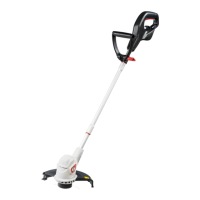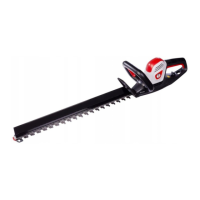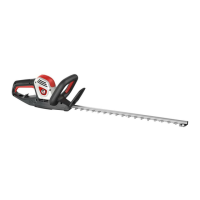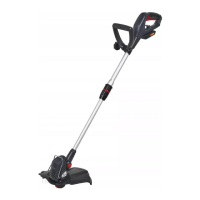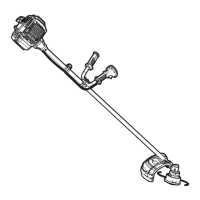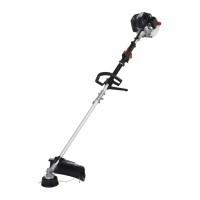164
FR
ES
PT
IT
EL
PL
RU
KZ
UA
RO
EN
C) Prevent unintentional starting. Ensure the switch is in the o-position
before connecting to power source and/or battery pack, picking up or
carrying the tool. Carrying power tools with your finger on the switch or
energising power tools that have the switch on invites accidents.
D) Remove any adjusting key or wrench before turning the power tool
on. A wrench or a key left attached to a rotating part of the power tool may
result in personal injury.
E) Do not overreach. Keep proper footing and balance at all times. This
enables better control of the power tool in unexpected situations.
F) Dress properly. Do not wear loose clothing or jewellery. Keep your hair
and clothing away from moving parts. Loose clothes, jewellery or long hair
can be caught in moving parts.
G) If devices are provided for the connection of dust extraction and
collection facilities, ensure these are connected and properly used. Use of
dust collection can reduce dust-related hazards.
H) Do not let familiarity gained from frequent use of tools allow you to
become complacent and ignore tool safety principles. A careless action can
cause severe injury within a fraction of a second.
2.7 POWER TOOL USE AND CARE
A) Do not force the power tool. Use the correct power tool for your
application. The correct power tool will do the job better and safer at the
rate for which it was designed.
B) Do not use the power tool if the switch does not turn it on and o. Any
power tool that cannot be controlled with the switch is dangerous and must
be repaired.
C) Disconnect the plug from the power source and/or remove the battery
pack, if detachable, from the power tool before making any adjustments,
changing accessories, or storing power tools. Such preventive safety
measures reduce the risk of starting the power tool accidentally.
D) Store idle power tools out of the reach of children and do not allow
persons unfamiliar with the power tool or these instructions to operate the
power tool. Power tools are dangerous in the hands of untrained users.
E) Maintain power tools and accessories. Check for misalignment or
binding of moving parts, breakage of parts and any other condition that may
aect the power tool’s operation. If damaged, have the power tool repaired
before use. Many accidents are caused by poorly maintained power tools.
F) Keep cutting tools sharp and clean. Properly maintained cutting tools
with sharp cutting edges are less likely to bind and are easier to control.
G) Use the power tool, accessories and tool bits etc. in accordance with
these instructions, taking into account the working conditions and the
work to be performed. Use of the power tool for operations dierent from
those intended could result in a hazardous situation.
H) Keep handles and grasping surfaces dry, clean and free from oil and
grease. Slippery handles and grasping surfaces do not allow for safe handling
and control of the tool in unexpected situations.
• Some regions have regulations that restrict the use of the product in some
operations. Check with your local authority for advice.
• Do not allow children, persons with reduced physical, sensory or mental
capabilities or lack of experience and knowledge, or people unfamiliar with
these instructions to use the product. Local regulations may restrict the age
of the operator.
• Keep in mind that the operator or user is responsible for accidents or
hazards occurring to other people or their property.
• Keep bystanders, children and pets 15 m away from the area of operation.
Stop the product if anyone enters the area.
• While operating the product, always wear substantial footwear and long
trousers. Do not operate the machine when barefoot or when wearing open
sandals. Avoid wearing clothing that is loose fitting or that has hanging cords
or ties; they can be caught in moving parts.
• Do not wear loose clothing or jewellery that can be drawn into the air inlet.
• Secure long hair so it is above shoulder level to prevent entanglement in
moving parts.
• Wear hearing protection at all times while operating the product. The
product is extremely noisy and permanent hearing injury may result if
instructions to limit exposure, reduce noise and wear hearing protection are
not strictly followed.
• Wear full eye protection at all times while operating the product. The
manufacturer strongly suggests a full face mask or fully enclosed goggles.
Normal spectacles or sunglasses are not adequate protection.
• Before each use, ensure that all controls and safety devices function
correctly. Do not use the tool if the o switch does not stop the product.
• Before each use, always inspect the housing for damage. Ensure that
guards and handles are in place and properly secured.
• Never operate the product with defective guards or shields, or without
safety devices, such as debris collector, in place.
• Keep all cooling air inlets clear of debris.
• Clear the work area before each use.
• Wear a face filter mask in dusty conditions to reduce the risk of injury
associated with the inhalation of dust.
• Do not point the product in the direction of people or pets.
• Do not operate the product near open windows, etc.
• Do not use the power tool if the switch does not turn it on and o. Any
power tool that cannot be controlled with switch is dangerous and must be
repaired.
• Disconnect thepower plug from the power tool before making any
adjustments, changing accessories, or storing power tools. Such preventive
safety measures reduce the risk of starting the power tool accidentally.
• Store idle power tools out of the reach of children and do not allow
persons unfamiliar with the power tool or these instructions to operate the
power tool. Power tools are dangerous in the hands of untrained users.
• Maintain power tools. Check for misalignment or binding of moving
parts, breakage of parts and any other condition that may aect the power
tool’s operation. If damaged, have the power tool repaired before use. Many
accidents are caused by poorly maintained power tools.
• Know how to stop the product quickly in an emergency
